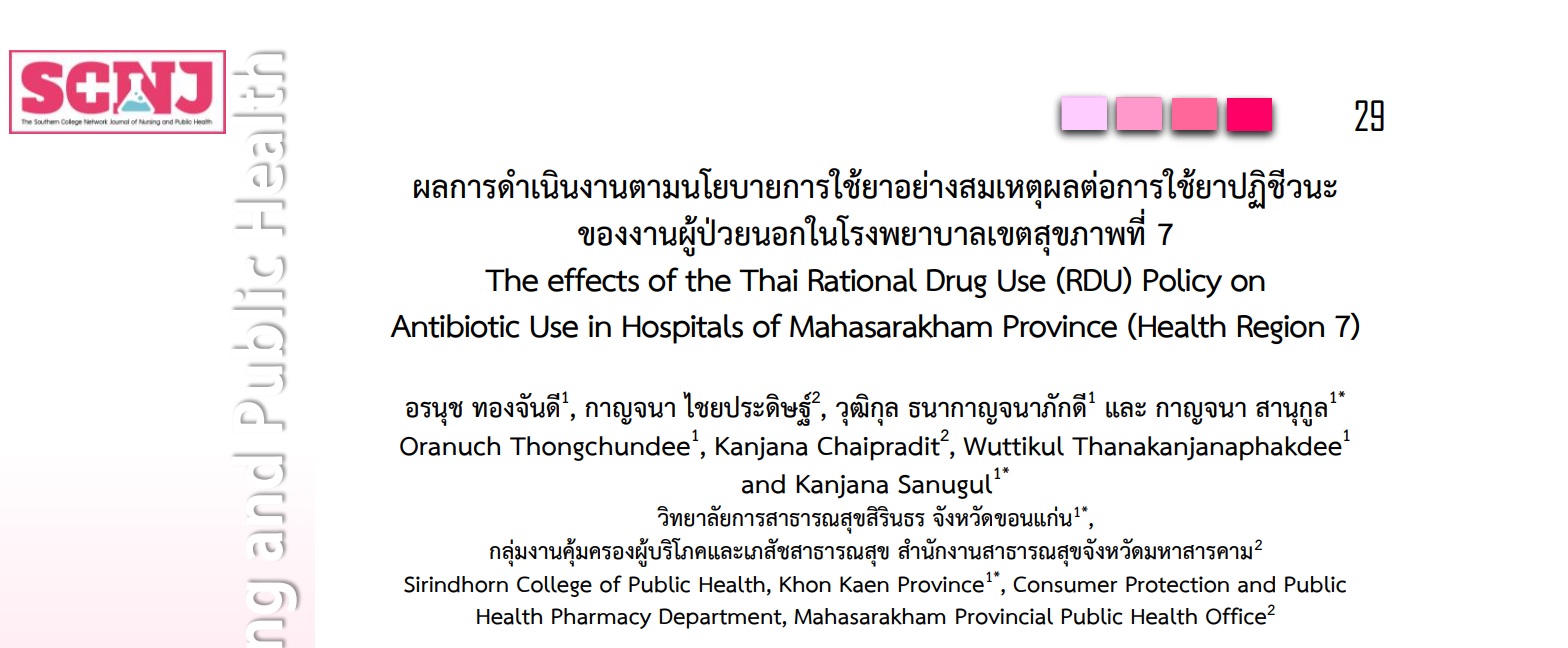ผลการดำเนินงานตามนโยบายการใช้ยาอย่างสมเหตุผลต่อการใช้ยาปฏิชีวนะ ของงานผู้ป่วยนอกในโรงพยาบาลเขตสุขภาพที่ 7
คำสำคัญ:
การใช้ยาอย่างสมเหตุผล, ปริมาณการใช้ยาปฏิชีวนะ, สมการถดถอยแบบเป็นช่วง, การวิเคราะห์ข้อมูลอนุกรมเวลาที่มีการแทรกแซงบทคัดย่อ
การวิจัยนี้มีวัตถุประสงค์เพื่อศึกษาผลการดำเนินงานตามนโยบายการใช้ยาอย่างสมเหตุผลของกระทรวงสาธารณสุขต่อปริมาณการใช้ยาปฏิชีวนะของงานผู้ป่วยนอกของโรงพยาบาลในจังหวัดมหาสารคาม และเพื่อศึกษาปริมาณการใช้ยาปฏิชีวนะของงานผู้ป่วยนอกของโรงพยาบาลในจังหวัดมหาสารคาม (พิจารณาจาก DDD ต่อ 1000 OP visits) ของผู้ป่วยนอกโรคติดเชื้อที่ระบบการหายใจช่วงบนและหลอดลมอักเสบเฉียบพลัน โรคอุจจาระร่วงเฉียบพลัน และบาดแผลสดจากอุบัติเหตุที่เกิดภายใน 6 ชั่วโมงก่อนได้รับการรักษา ในระหว่างก่อนดำเนินนโยบาย 12 เดือนและหลังดำเนินนโยบาย 12 เดือน (เดือนตุลาคม 2558 ถึงกันยายน 2560) โดยใช้ข้อมูลจากการบันทึกใน 43 แฟ้มของงานผู้ป่วยนอกของโรงพยาบาลในจังหวัดมหาสารคาม โดยประเมินผลการดำเนินงานตามนโยบายด้วยการวิเคราะห์ข้อมูลอนุกรมด้วยสมการถดถอยแบบเป็นช่วงและข้อมูลปริมาณการใช้ยาปฏิชีวนะทำการวิเคราะห์ด้วยสถิติเชิงพรรณนา ผลการวิจัยพบว่า
1. ปริมาณการใช้ยาปฏิชีวนะในช่วงก่อนเริ่มใช้นโยบายมีแนวโน้มเพิ่มขึ้นทุกเดือนประมาณ 1.579 DDD ต่อ 1000 OP visits (95% CI:-16.708 to 19.902, p=.857) เมื่อเริ่มดำเนินการตามนโยบายในเดือนแรกพบว่าปริมาณการใช้ยาปฏิชีวนะต่อเดือนลดลง 25.639 DDD ต่อ 1000 OP visits โดยไม่มีนัยสำคัญทางสถิติ (95% CI: -220.056 to 168.780, p=.786) และหลังการดำเนินนโยบายปริมาณการใช้ยาปฏิชีวนะมีแนวโน้มลดลง 24.480 DDD ต่อ 1000 OP visits ทุกเดือนเมื่อเปรียบเทียบกับก่อนมีนโยบาย โดยไม่มีนัยสำคัญทางสถิติ (95% CI: -51.907 to 2.945, p=.077) การประมาณแนวโน้มปริมาณการใช้ยาปฏิชีวนะต่อเดือน (DDD ต่อ 1000 OP visits) เมื่อดำเนินการตามนโยบายการใช้ยาอย่างสมเหตุผลพบว่ามีปริมาณการใช้ยาปฏิชีวนะต่อเดือนลดลงที่อัตรา 22.884 DDD ต่อ 1000 OP Visits อย่างมีนัยสำคัญทางสถิติ (95% CI:-42.071 to-3.696, p= .022)
2. ปริมาณการใช้ยาปฏิชีวนะระหว่างเดือนตุลาคม 2558 ถึงกันยายน 2559 เท่ากับ 20,473.20 DDD ต่อ 1000 OP Visits และระหว่างเดือนตุลาคม 2559 ถึงกันยายน 2560 เท่ากับ 18,779.81 DDD ต่อ 1000 OP Visits
ผลการวิจัยแสดงให้เห็นว่าการดำเนินนโยบายการใช้ยาอย่างสมเหตุผลทำให้มีการใช้ยาปฏิชีวนะอย่างสมเหตุผลมากขึ้น ส่งผลให้ปริมาณการใช้ยาปฏิชีวนะของงานผู้ป่วยนอกของโรงพยาบาลในจังหวัดมหาสารคามมีแนวโน้มลดลง ดังนั้นนโยบายการใช้ยาอย่างสมเหตุผลเป็นอีกหนึ่งกลยุทธ์ที่มีความสำคัญในการนำมาประยุกต์ใช้เพื่อลดเชื้อดื้อยาในโรงพยาบาล
เอกสารอ้างอิง
Centers for Disease Control and Prevention. (2022). Archived: 2019 AR Threats Report. Retrieved from: https://www.cdc.gov/drugresistance/biggest-threats.html
Chaiyasong, C., Tiyapak, P., Supathaweewat, S., Mithala, S., & Chaiyasong. S. (2019). Effect of Rational Drug Use Policy on Antibiotic Prophylaxis Use in Normal Vaginal Delivery in Mahasarakham Hospital. Journal of Health Systems Research, 13(3), 261-270.
Ansari, F., Gray, K., Nathwani, D., Phillips, G., Ogston, S., Ramsay, et al. (2003). Outcomes of an Intervention to Improve Hospital Antibiotic Prescribing: Interrupted Time Series with Segmented Regression Analysis. J Antimicrob Chemother, 52(5), 842-848.
Junkunapas, P. (2016). Service Plan: Rational Drug Use. Nonthaburi: Office of Permanent Secretary Ministry of Public Health. Retrieved April 20, 2022 from https://r8way.moph.go.th/ r8wayadmin/page/uploads_file/20170306112339_9.%E0%B8%84%E0%B8%B9%E0%B9%8B%E0%B8%A1%E0%B8%B7%E0%B8%ADService%20Plan%20RDU.pdf
Linden, A. (2015). Conducting Interrupted Time-Series Analysis for Single-and Multiple-Group Comparisons. The Stata Journal, 15(2), 480-500.
National Antimicrobial Resistance Surveillance. (2013). Situations of Antimicrobial Resistance in Thailand. Retrieved April 20, 2022 from: http://narst.dmsc.moph.go.th/news001.html
Rational Drug Use Sub-Committee. (2015). Rational Drug Use Hospital Manual. 1st ed. Bangkok: The Agricultural Co-operative Federation of Thailand. Retrieved April 12, 2022 from https://www.fda.moph.go.th/sites/drug/Shared%20Documents/National-Drug-Policy/06/RDU%20final_220615.pdf
World Health Organization. (2011). Archived: Step-By-Step Approach for Development and Implementation of Hospital and Antibiotic Policy and Standard Treatment Guidelines. Retrieved April 12, 2022 from https://apps.who.int/iris/handle/10665/205912
World Health Organization. (2022a). Archived: Definition and General Considerations. Retrieved April 25, 2022 from https://www.whocc.no/ddd/definition_and_general_considera/
World Health Organization. (2022b). Archived: DDD Alterations from 2005-2021. Retrieved April 25, 2022 from: https://www.whocc.no/atc_ddd_alterations__cumulative/ddd_alterations/
Wagner, A. K., Soumerai, S. B., Zhang, F., & Ross-Degnan D. (2002). Segmented Regression Analysis of Interrupted Time Series Studies in Medication Use Research. J Clin Pharm Ther, 27(4), 299-309.
Zhen, L., Jin, C., & Xu, H. N. (2018). The Impact of Prescriptions Audit and Feedback for Antibiotic Use in Rural Clinics: Interrupted Time Series with Segmented Regression Analysis. BMC Health Serv Res, 16;18(1), 777.

ดาวน์โหลด
เผยแพร่แล้ว
ฉบับ
ประเภทบทความ
สัญญาอนุญาต
ลิขสิทธิ์ (c) 2022 วารสารเครือข่ายวิทยาลัยพยาบาลและการสาธารณสุขภาคใต้

อนุญาตภายใต้เงื่อนไข Creative Commons Attribution-NonCommercial-NoDerivatives 4.0 International License.
1. บทความหรือข้อคิดเห็นใด ๆ ที่ปรากฏในวารสารเครือข่าย วิทยาลัยพยาบาลและการสาธารณสุขภาคใต้ ที่เป็นวรรณกรรมของผู้เขียน บรรณาธิการหรือเครือข่ายวิทยาลัยพยาบาลและวิทยาลัยการสาธารณสุขภาคใต้ ไม่จำเป็นต้องเห็นด้วย
2. บทความที่ได้รับการตีพิมพ์ถือเป็นลิขสิทธิ์ของ วารสารเครือข่ายวิทยาลัยพยาบาลและการสาธารณสุขภาคใต้







